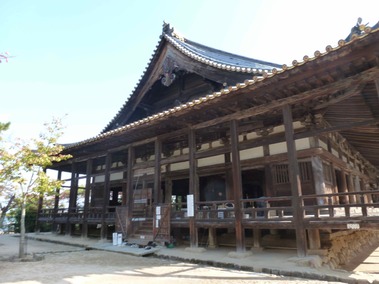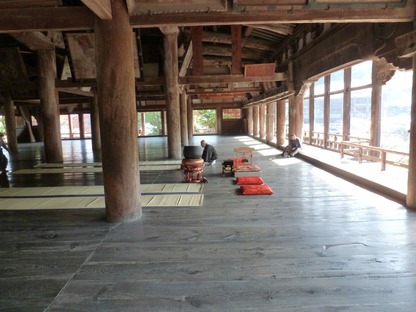
I'd done a bit of research prior to our departure from Australia, and had pencilled in a lengthy walking tour around the temple precinct, starting at Senjokaku Temple, passing the Five Storey pagoda and a couple of lesser shrines and meandering around the mountainside Nature Walk before looping back to the main temple area.
Madam was determined to make for Mount Misen via the rope way, but the morning weather conditions made that idea a bit iffy, so we started with Senjokaku, where there were obvious preparations for something or other under way.
Senjokaku (Hall of One Thousand Tatami Mats) is the colloquial name for Toyokuni Shrine, originally built by Toyotomi Hideyoshi (one of the three unifiers of sixteenth century Japan) in 1587, but left incomplete after his death. The nickname is a fairly apt description of the largest structure on Miyajima, which doesn't actually contain much apart from empty space.

According to a letter from Ankokuji Ekei, head monk of Ankokuji Temple, the intention was to build a Buddhist library in which the chanting of sutras could be held every month to honour those killed and wounded in times of war. The incomplete structure was left unpainted, and since the exact year it was built is known, the weathering of its pillars and floor boards can be used to determine the age of other wooden structures on Miyajima.
Senjokaku is, however, a slight exaggeration. The area of floor space is equal to a 857 tatami mats.
From there, once we'd reclaimed the footwear we’d removed so we could enter the temple we made our way past the 27.6 metre Five Storey Pagoda (Goju-no-to), built in 1407 and it restored in 1533, enshrining the Buddha of Medicine and Buddhist saints Fugen and Monju and into the back streets that would take us past Zonkoji, Tokujuji and Shinkoji temples on the way to a road the handy map had labelled the Nature Walk. Given the coloured leaves theme it seemed the way to go.
It was evident that the further you went from the main tourist areas, the less crowded things became, and by the time we hit the Nature Walk we had things more or less to ourselves.
The ramble through the foothills was a rather pleasant contrast from the bustling conditions a few hundred metres away, and the foliage was definitely on the autumnal turn, giving Madam a considerable degree of heartache due to the sunlight's continued refusal to play nicely and deliver optimal conditions for coloured leaves photography.
That meant, once we reached the point where a decision regarding the rope way needed to be made, the consensus was to head back into the throng rather than up the mountain. Still, once we were back with the crowd we tended to work away from the mob, heading for Daisho-in rather than the main temple complex. A five-minute walk from Itsukushima Shrine at the foot of of Mount Misen, Daisho-in is one of the most important temples of Shingon Buddhism.